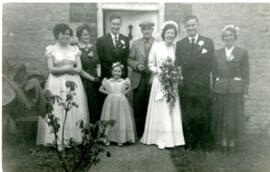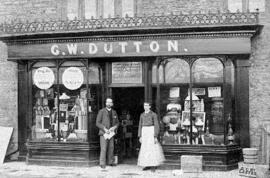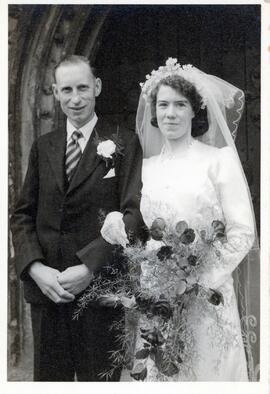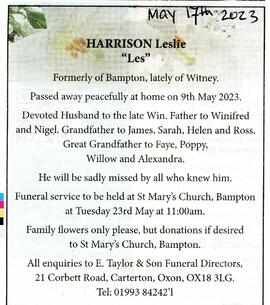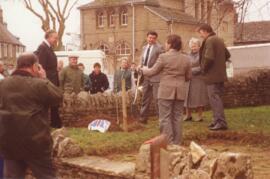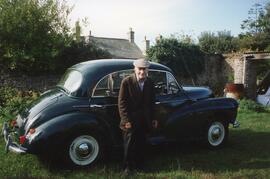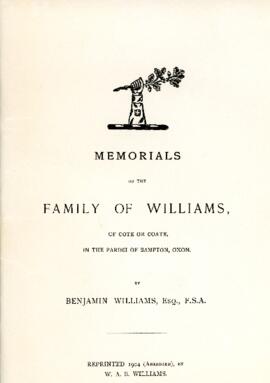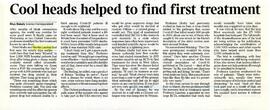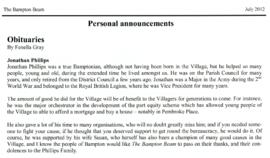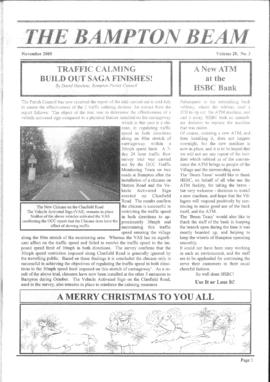- BCA - 2023.6341
- Item
- 1930
21 photos showing The Old Chapel Cottage in Buckland Road taken spring 2004.
Front cover of the funeral program for Dinah Lucy Green born September 7th 1930, died October 21st 2013
An invoice issued to Mrs Bessie Green by William Mathews family grocer inBampton in the shop called Duttons. Bessie worked in the shop and she also did some baking for other people. Her list includes 2lb granary sugar, 1lb caster sugar, 1lb cheese, ½lb rashers, 1lb margarine, ½lb butter, ½lb lard, 1lb currants, 1lb sultanas, ¼ lb mixed peel, ½lb suet, large peaches, custard powder, table salt, small Omo (a laundry powder), rose mansion, ½lb sweet biscuits, Bisto (gravy granules), SR flour, 1 Chunky (a dog food), total cost £1.7s.2d (£135½p)
newspaper cutting – children outside the Town Hall with their flower garlands
ready for judging 1964. Children include Gillian & Sheila Harding, Susan Taylor, Esther Green and her
mother Dinah and her grandmother Bessie Green.
Img140 School carnival 1985 with Dinah and Freda Bradley, Dinah dressed as a Pearly Queen.
Img141 1985 school carnival float with Jan Bone, Bernice, Olive, Freda Bradley, Rita, Dinah
and Sylvia Nicholson.
Img142 1984 school carnival float with Dinah dressed in the uniform of the Women’s Land
Army.
Img143 Dinah is standing next to Maurice Buckland and she’s dressed as a Pearly Queen.
They got first prize for their float and Dinah’s holding the £10 note.
Img144 1985 school carnival with Dinah in Women’s Landy Army uniform – the theme for
their float was ‘Women’s Fashion 1900 to 1980s’.
Img145 1986 school carnival float, Dinah dressed as a jockey as her part in the their float
with the theme ‘Royal Ascot.’ Others on the float were Rita Head, Freda Bradley, Bernice Surridge,
Rosemary and Mavis Cooper.
Img147 1958 or 1959 with Esther Green, Dinah’s daughter, dressed as a poppy with a sign
‘Haig Fund’ in front of her. This was the name given to what is now the Poppy Appeal. Dinah is
supporting a little Esther.
Img148 1964 and Esther is dressed up to recall records; she has a disk hanging in front of her
and a waist band that says Top Ten. The children in fancy dress are all parading past the Jubilee Inn.
Dinah is in the centre of the picture walking behind Esther.
Img156 1971 or 1972. Ann Irvine and Dinah green taking part in the celebration of Bampton
Branch of the WI in their Golden Jubilee year. The WI planted a tree by the War Memorial to
commemorate the occasion. Dinah was a wonderful needlewoman and did nearly all the quilting
seen in this picture.
Img157 Dinah with Curly, real name John Titchener who is wearing the smock she made for
the first time.
Img080 and 081 The wedding of Dinah Lucy Godfrey and Ramon James Green on May 15th
1954 – one of the pictures has the names printed on it and they are also shown on the back.
Img082 July 2004, the wedding of Dinah’s son Mathew to Jackie. Mathew’s father Ramon
and sister Esther are in the family group
Nik Stanbridge

